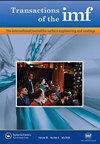Novel Room Temperature Molten Salts for Aluminium Electrodeposition
IF 1.5
4区 材料科学
Q4 ELECTROCHEMISTRY
Transactions of The Institute of Metal Finishing
Pub Date : 1999-01-01
DOI:10.1080/00202967.1999.11871238
引用次数: 11
Abstract
SUMMARYThis work describes novel room temperature molten salts which can be used for aluminium electrodeposition. We have characterised the conductivity as a function of the bath composition and shown that the changes in conductivity occur because of an equilibrium between [Al2Cl7] and [AlCl2 The voltammetry of the optimum melt is analysed together with the mechanism of nucleation. Hull cell tests were performed and the morphology of the deposits was analysed using scanning electron microscopy. These room temperature molten salts have a number of advantages over those described in the literature including lower water sensitivity, greater ease of purification and greatly reduced cost. The electrodeposition of adherent, dull aluminium is demonstrated. It is also shown that soluble aluminium anodes can be used. These novel baths form a viable alternative to conventional methods of depositing aluminium.新型铝电沉积用常温熔盐
本工作描述了一种可用于铝电沉积的新型室温熔盐。我们将电导率表征为熔池组成的函数,并表明电导率的变化是由于[Al2Cl7]和[AlCl2]之间的平衡而发生的。进行了壳细胞试验,并使用扫描电子显微镜分析了沉积物的形态。与文献中描述的熔盐相比,这些室温熔盐具有许多优点,包括较低的水敏感性,更易于净化和大大降低成本。电沉积的粘附,暗铝演示。结果表明,可溶铝阳极是可行的。这些新颖的槽形成了传统沉积铝方法的可行替代方案。
本文章由计算机程序翻译,如有差异,请以英文原文为准。
求助全文
约1分钟内获得全文
求助全文
来源期刊

Transactions of The Institute of Metal Finishing
工程技术-材料科学:膜
CiteScore
3.40
自引率
10.50%
发文量
62
审稿时长
3 months
期刊介绍:
Transactions of the Institute of Metal Finishing provides international peer-reviewed coverage of all aspects of surface finishing and surface engineering, from fundamental research to in-service applications. The coverage is principally concerned with the application of surface engineering and coating technologies to enhance the properties of engineering components and assemblies. These techniques include electroplating and electroless plating and their pre- and post-treatments, thus embracing all cleaning pickling and chemical conversion processes, and also complementary processes such as anodising. Increasingly, other processes are becoming important particularly regarding surface profile, texture, opacity, contact integrity, etc.
 求助内容:
求助内容: 应助结果提醒方式:
应助结果提醒方式:


